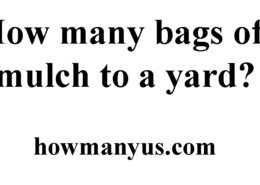How many bags of mulch to a yard?
How many bags of mulch to a yard? The question “How many bags of mulch to a yard?” pertains to understanding the amount of mulch needed to cover a certain area, typically measured in cubic yards, using commercially available bags of mulch. Mulch is commonly used in gardening and landscaping to retain moisture, suppress weeds, and enhance the appearance of flower beds, gardens, and other outdoor spaces.
To answer this question, it’s important to consider the volume of mulch in a bag and how much area (in square yards) a bag can cover. Mulch bags are typically sold in various sizes ranging from 1 to 3 cubic feet per bag.
To convert cubic feet to cubic yards, remember that 1 cubic yard equals 27 cubic feet (since 3 feet × 3 feet × 3 feet = 27 cubic feet). Therefore, if you know the volume of the mulch bags in cubic feet, you can calculate how many bags are needed to cover a cubic yard of area.
How many bags of mulch to a yard?
This calculation helps homeowners, gardeners, and landscapers estimate the quantity of mulch required for their projects based on the size of the area they intend to cover.
The question “How many bags of mulch to a yard?” pertains to understanding the amount of mulch needed to cover a certain area, typically measured in cubic yards, using commercially available bags of mulch. Mulch is commonly used in gardening and landscaping to retain moisture, suppress weeds, and enhance the appearance of flower beds, gardens, and other outdoor spaces.
To answer this question, it’s important to consider the volume of mulch in a bag and how much area (in square yards) a bag can cover. Mulch bags are typically sold in various sizes ranging from 1 to 3 cubic feet per bag.
To convert cubic feet to cubic yards, remember that 1 cubic yard equals 27 cubic feet (since 3 feet × 3 feet × 3 feet = 27 cubic feet). Therefore, if you know the volume of the mulch bags in cubic feet, you can calculate how many bags are needed to cover a cubic yard of area.
This calculation helps homeowners, gardeners, and landscapers estimate the quantity of mulch required for their projects based on the size of the area they intend to cover.


The query “How many bags of mulch to a yard?” is a practical question that many homeowners and landscapers ask when planning outdoor projects involving mulching. Mulch, a material commonly made from shredded wood, bark, or other organic matter, serves multiple purposes in gardening and landscaping, from retaining moisture to enhancing curb appeal.
The answer to this question depends on the volume of mulch each bag contains and the size of the area (in cubic yards) that needs to be covered. Mulch bags are typically available in various sizes, commonly ranging from 1 to 3 cubic feet per bag.
To determine how many bags of mulch are needed to cover one cubic yard (27 cubic feet) of area, follow these steps:
Therefore, if you’re using 2-cubic-foot bags of mulch, you’ll need approximately 13.5 bags to cover one cubic yard of area. Keep in mind that this is an estimate and may vary based on the specific volume of mulch per bag and the thickness of the mulch layer you intend to apply.
When purchasing mulch for landscaping projects, it’s advisable to buy a few extra bags to account for variations in coverage and ensure you have enough material to achieve the desired depth of mulch. Additionally, consider the type of mulch (e.g., organic vs. inorganic) and its intended purpose (e.g., flower beds, around trees) when calculating quantities for your landscaping needs.
In summary, the number of bags of mulch required to cover one cubic yard of area depends on the volume of mulch per bag. By understanding bag volume and converting cubic feet to cubic yards, homeowners and landscapers can accurately estimate the amount of mulch needed for their outdoor projects.